

VRELO UNE 2007
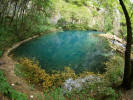


Zrmanjin Zov 2007 (by Gigi
Casati):
Croatia has been a fixed appointment
over the last few years. The growing friendship with Tihi and the DDISKF members
have allowed us to optimize over time the organization of our explorations in
this amazing country.
On July 21 the Zrmanjin Zov
expeditions (Zrmanja is the name of a canyon, Zov means “view”) is officially
launched with a short speech from the organizer Tihi, the notes of the Croatian
national anthem and a nice party that everybody enjoys, including the cave
divers and the local authority representatives.
First target
of the expedition is a spring new to us but explored some years ago by a
Frenchman up the depth of -50m.
On the
morning of July 22 we leave the base camp located in Obrovac, direction Donja
Suvaja, at about an hour drive distance. The journey offers some fascinating
landscapes, likewise the whole of Croatia does, by the way.
On the way,
after one of the many sharp turns of the road, we stop to rescue a motorcyclist
which had just fallen down and most likely has broken his shoulder. As soon as
we realize that our help is no more necessary, we go back to the car and keep
going towards our destination. Once we get there, we set up the forward camp on
Marco’s property, a local trout breeder. We take the equipment down from the
cars, prepare everything we need for a first dive scouting in safety and we
reach the area where we must leave our cars.
The
equipment, arranged into speleological bags, is carried by ten speleologists on
their strong shoulders and taken to the spring Vrelo Une along a 15 minutes walk
which first climbs sharply then heads down to the lake. While walking, I am able
to catch a glimpse of the small lake in between the thick wood: the dark blue of
the water creates a strong contrast with the vivid green of the trees and I feel
the adrenaline rising inside me. I can’t wait to explore that cave!
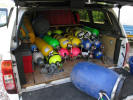
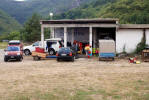
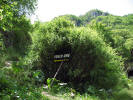
Around
the small lake, the mountain wall rises vertically for more than 100m against
the clear blue sky. The lake is around 50m wide and 20m long, the water
temperature is 9 degrees Celsius and, at first sight, visibility doesn’t look
too bad. Once we finish installing the regulators on the safety tanks that we
will put into the water for any eventual emergency situations (such as technical
problems with our rebreathers), the long awaited operation of putting on the dry
suit and the rest of the equipment finally comes.
Besides me,
Alan gets into the water with his camcorder to take some shots of the cave
preparation and Alen also goes down to help me to position the tanks along the
way. Firstly I take care of positioning the safety rope and tanks for the deep
dive; Alen follows me and set a 10lt oxygen tank at -6m, a 15lt 50/20 nitrox
tank at -21m and a 15lt 36/36 nitrox tank at -36m depth. Alan swims around me
with his videocamera taking advantage of all the times I need to stop to fasten
the rope or to prepare the knots to secure the tanks. I set one last 15lt 25/60
tank at -50m and I keep going from there towards unexplored areas: the cave has
a very vertical development, many tree trunks create fascinating and mysterious
shapes and shadows, the wall appears incredibly eroded.. everything makes me
believe that long time ago this spring was a swallowing pit.
I reach -70m
and there I leave a 20lt 20/70 tank. Alan stops here while I let myself fall
into the abyss. I can’t see the entire tunnel and neither its size, so I just
follow one of its wall. The visibility is approximately 6m, also due to the
relative darkness of the wall’s rock, and soon I found myself at -90m, where I
leave the last 20lt 15/75 relè tank and keep on me one 20lt extra-tank and one
7lt tank for my rebreather.
But I am not
yet satisfied and so I let myself sink down to -103m, at a distance of 140m from
the cave’s entrance, and there I finally make the decision to stop the
exploration leaving the reel hung up in the void.
After 20
minutes, while I am starting to go up, I take a look around to try and
understand how big that hole in the rock is; more or less, it should be 20-30m
by 5-10m. I get to the surface in just less than one hour, thrilled by the
experience and with one single thought in my mind: reset the equipment for
tomorrow!
In the
evening I am informed that Jean Jacques Bolanz, partner of so many adventures,
will join me on July 23 late morning, while Alessandro will arrive in the
afternoon. That night only Alen and I stay, while the other speleologists drive
back to Obrovac to pursue other explorations.
The
following morning, after the arrival of Jean Jacques, we go to the spring where
I want to continue immediately the exploration. Though a number of problems
occur that delay my start. First of all a problem to a sensor which is quickly
solved by borrowing on from Jean Jacques, then I realize that the Hid lights
don’t work because the day before they had flooded and I had not noticed it,
then – dulcis in fundo – I am missing the connection between the condom
and the P-valve of my dry suit. Therefore, I can’t do anything else that lower
my ambitions and go down to secure the safety tanks on a 7mm rope at -90m: I am
not comfortable with the idea of leaving them hung in the void on a tiny 2mm
exploration rope.
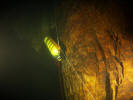
On July 24 I
take the day to rest and look at Jean Jacques getting ready to go and begin the
topography and a striking idea comes to my mind: I propose Jean Jeacques to
choose between doing the topography and continuing with the exploration. And, at
the age of 67, Jean Jacques replies to me, with the enthusiasm of a teenager and
in no time, that he is definitely for the exploration. So I help him to set-up
the equipment and, together with Alen and Alessandro, we take all the material
to the spring. With his usual calm, Jean Jacques gets ready, gets in the water
and after a few minutes disappears under the surface. Alen, in his wet suit,
assists Jean Jacques during the decompression, while Alessandro dives into the
cave to familiarize with it.
Jean Jacques
is back to the surface after 160 minutes of dive and, with the most happy look
in his eyes, tells me that he had reached -123m, at the very bottom of the pit
and that his main helmet lights went off. Soon after we also notice that his
canister had flooded too. At dinner, Jean Jacques describes the dive in details
and listening to him I start thinking that after a certain point the cave
changes direction and probably heads up towards the surface.
On July 25
it’s again my turn to continue the exploration and, after a good breakfast, we
get to Vrelo Une where all our gears and equipment are already ready for the
dive. For no particular reason, I can’t stay as mentally focused as usual, but
once I get in the water to complete the operations of preparation, in a second I
reach the greatest level of concentration possible.
Beyond the
rebreather and its 7lt 5/85 tank, I take on me two 20lt safety tanks with two
different gas blends, one with 12/80 and the other with 8/85. Once under the
surface, I go down quickly reaching -70m in 3 minutes and -123m in 5 minutes;
the reel is there waiting for me on a rock at the beginning of a creek that
keeps going down below. I think for a second of us talking about going beyond
that point the night before and I smile.
I start
going down, observing in details as much as I can the surrounding morphology,
and I reach a tree trunk to which I secure the rope before going further down.
Another tree trunk with diameter of 70cm lays there crossways in the creek; a
glance to the depth gauge, I am at -150m and I feel all right, so I decide to
continue the descent. At the depth of -163m, 230m away from the cave entrance, I
leave the reel at the base of an enormous rock. It’s taken me only 10 minutes to
get there.
I take a
look around myself, I can see the side walls of hard rock, below and in front of
me the most absolute void and where I leave the reel there are many rocks, some
small some big: the steep slope is a clear warning to not touch anything with
the fins.
I start to
go back up. At -120m I take a quick tour around what seems to be a large cave
with the bottom covered by an impressive composition of tree trunks and
branches, but I stay very little as I don’t want to waste time and accumulate
decompression minutes.
Exactly one
hour after my initial departure from the surface, Alessandro reaches me with a
new battery for my electric jacket and a flask of fresh water with minerals.
Alen comes to see me at the second hour and, given that everything is going
well, he decides to stay with me till the end of the decompression time. I get
back to the surface after 147 minutes of dive and out there I find thirty people
interested in our adventure and ready to warmly congratulate with me for the
achievement.
On July 26
Jean Jacques and Alessandro start to draw the topography of the cave beginning
from the depth of -58m up to entrance; Alen goes exploring some small tunnels at
few meters of depth.
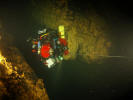
On
July 27 they continue the topography till the depth of -107m and check out other
secondary tunnels and caves which, though, don’t lead to any relevant
exploration.
On July 28,
after two endless day spent looking to the other guys diving, I am finally ready
for a new exploration attempt. We get to the lake later than usual, it’s almost
noon. I had prepared everything the day before, so the only things I have to do
are to perform a final check of the analyzers’ calibration and to wear gear and
equipment. Once in the water, I go down to -6m to check the sensors and I get up
to the surface to say that it is all right. A greeting to everyone and I swim
across the lake looking for the exact point were the vertical hole is more
direct and free.
Just before
going down, I empty completely counterlungs of my reb to exhale all the oxygen,
I open the dry suit’s valve and I start my fast descent.
I
get to the depth of -40m in one minute, then I need to use the fins to push
myself deeper and here I am at -70m; from there I am able to go down vertically
to -123m. During this last trunk, I keep the PpO2 at 0.6 to avoid the generation
of too much oxygen in the gas blend which would force me to perform a cleaning
cycle of the rebreather. Passed that point, I set the PpO2 to 1 and continue to
quickly go down. I use a diluting mix 3/90 and by doing so I am able to keep the
PpO2 easily under control, even if at times I have to close the oxygen flow. I
stay at a few meters’ distance from the rope in order to better observe the hole
and to use the fins without worries. In eight minutes I reach the reel that I
left at -163m.
I feel so
much and so strongly the attractiveness of the unknown that it is like a loud
scream inside me, but I keep it under control, I pick up the reel and unlock it,
while I look at the slope that continues below me.
I kick
myself down by pushing the fins on the floor to gain some speed, but this turns
out to be a very bad move as the pressure in the rock generates an immediate
landslide: in front of me there is a huge rock and fearing it can fall on me, I
move horizontally to the side for a few meters in the creek while holding the
reel strongly in my hand. The clay lifted by the landslide is swallowed from the
bottom of the cave and I decide to stand there and wait, suspended in the void,
still. After three long minutes, when the anger of the rocks seems to cool down,
I hear three scaring thuds as if huge rocks had violently landed on a flat floor
far away down below.
I go a
little further down, but at the depth of -175m I must stop: below me there is a
very thick cloud of clay impossible to penetrate. So I lock the reel and I leave
it hung there in the middle of the creek. I realize then that one of my three
analyzers has mysteriously turned off.
When
I begin my ascent I have been in the water only for 13 minutes and I have plenty
of time during the decompression to think back to my mistake. It’s very well
known that being in a hurry can lead to irrational behavior and increases the
possibility to make poor mistakes. I also have plenty of time to report on a
small whiteboard the exact depth where the tree trunks lay and other interesting
things about the environment down there in the cave.
At the depth
of -120m, my analyzer “magically” turns on again. The two assistant cave diver
Alen and Alessandro are punctual and efficient as usual throughout the entire
decompression time. I get back to the surface after 186 minutes.
On July 29
Jean Jacques gets ready for the exploration of the big cave at -120m, but once
we get to the lake we found a very disappointing surprise: visibility is down to
about 50cm. During the last few days, little water has flown through and the
weather conditions have been stable, so the only plausible explanation of this
major change in the water conditions is that the cloud of clay I had lifted had
slowly come up during the night, drifted by the current, up to the surface.
Nobody gets in the water and we spend the day fixing the equipment damaged
during the past few dives. We identify and solve the problems with the battery
packs, I replace the battery of the analyzer, I check some of the regulators,
and we spend the remaining of the day reading and writing the expedition report.
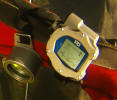
On July 30
the water conditions are better but visibility is still only 3m. Hoping to gain
back a good visibility on the following day to try and continue the exploration,
and without losing our optimism, we go to the beach to swim and relax.
On July 31 we
can see enough from the surface to hope in good conditions underwater: we can
see the safety tank at -6m. Over the past two free days, we could prepare and
fix in every single detail the entire equipment.
In the
morning, Lorenzo, who will make photographs starting from the deep area at
-120m, joins us.
The sky is
cloudy and the air temperature is 10 degrees Celsius, perfect conditions to wear
the heavy undersuit without sweating. Yesterday’s good swim of more than 4km has
provided me with a great deal of energy and I feel in very good shape. While I
get ready, I mentally go through the key reference points of the cave and the
key operations to perform so that I can anticipate every single movement of my
body. I will go down as fast as I can and this time I don’t want to make any
mistake.
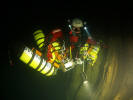
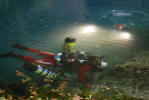
In
4 minutes I get to the depth of -123m and I know I need to control the power in
my legs to avoid an increase in the breathing frequency. Visibility around here
is about 4m, very different from the previous days. I keep going down till -163m
maintain, this time, a good distance from the bottom and I get to the vertical
point where I had left the reel below me. I hold it in my hand while the thin
layer of mud that was covering it gets all around me like a cloud. The walls too
are covered by at least half a centimeter of clay that could easily mix up in
the water at the lightest touch or water pressure.
At the depth
of -180 I find another tree trunk and I think of how unbelievable it is to find
one down there, given that the creek is not fully vertical from the surface.
I continue my
descent and finally at -190m I can see the bottom, a steep slope of gravel below
me. I go further down moving on a diagonal to gain depth with the least effort
possible. One of the analyzer turns off, but this time I have four on me to feel
safer. I can see a possible anchor point but when I get close to it, I realize
that it is not a good point to secure the rope and therefore I go down some
extra meter and finally find what I was looking for.
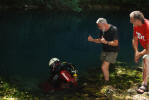
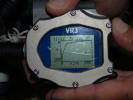
My hands shake, HPNS or
fear, I don’t know. But my mind is vivid clear. I decide to take the shears out
of the elastic band, to cut the rope, to make the knot, the secure the reel, to
use again the shears and, finally, to go up a bit.
I then look at the depth
gauge and I see that in 12 minutes I have reached the depth of -205m at a
distance of 290m from the surface.
The little
clouds of clay I go through during my ascent create a surrealistic atmosphere. I
can’t avoid thinking to the three strong thuds I heard during my last dive. How
can I forget? This can’t be the point where the big rocks have landed because,
with the steep slope and the gravel on the bottom, the noise should have been
more soft. “Who knows what’s below that”..
I do a first
stop of one minute at -160m exactly above the big rock: I have all the time to
take a close look to it and I notice that it is a conglomerate of rocks. A
de-pigmented shellfish with long antennas, which for sure has no problems with
HPNS nor with decompression, comes to make me a kind visit. At -123m I pick up
the 20lt tank that I had left for eventual emergency. After 25 minutes, at
-117m, I reach Lorenzo: an extra deep-stop to capture a few images and then we
go slowly up together filming the most interesting spots.
On my way
up, I also pick up the other two 20lt tanks at -90m and -70m as well as the rope
to which they were secured. And precisely in recovering the rope, I believe I
generated fatigue to the forearms and, consequently, as soon as I get around
-40m I start feeling some pain. I slow the ascent down a bit in order to be able
to address the problem while remaining as deep as possible and I manage to stay
at -21m for 30 minutes at a PpO2 of 1.6. Then suddenly the pain vanishes. I get
rid of the five 20lt tanks, I drink and I eat some watermelon slices. I have all
I need to do a relaxing decompression.
After 295
minutes I get to the surface happy and satisfied: the explorative dives are
over. We take most of the equipment to the cars, leaving at the cave only the
minimum set necessary to complete the drawing and to recover the gears.
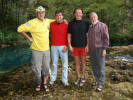
I already
dream of the day when, next year, I will be back in Vrelo Une to try to continue
the deep dive exploration, but also to see how wide really is that attractive
wall creek and, who knows, to may be find the place where those rocks have
landed..
Participants: Alan Kovacevic (preliminary dive to -55 and video), Alen
Milosevic, Alessandro Fantini, JJ Bolanz (topography), Lorenzo Del Veneziano
(photos), Luigi Casati and above all Tihomir Kovacevic and the DDISKF, his
speleoclub.

[Novità]
[News] [Dernières Nouvelles]
[Noticias]
[Home Page]
[Curriculum Vitae]
[Attività]
[Esplorazioni] [Album
Foto] [Corsi]
[Commenti]
[Home Page ENG]
[Curriculum Vitae ENG]
[Activity]
[Explorations] [Photo
Album] [Courses]
[Comments]
[Home Page FRA]
[Curriculum Vitae FRA]
[Activité] [Explorations]
[Photo
Album FRA] [Formations]
[Commentaires]
[Home Page ESP]
[Curriculum Vitae ESP]
[Actividades]
[Exploraciones] [Album Fotografias]
[Cursos Buceo]
[Comentarios]
[E-M@il]